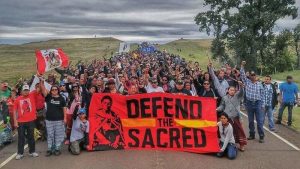The North Dakota Access Pipeline has been the subject of intense debate between environmentalists and Native American tribes against pipeline constructers Dakota Access LLC since the beginning of its development in 2014. Finally, two years later, protesters cheer in celebration as work on the pipeline has come to a halt.

The 1,172 mile pipeline, which was intended to transport light, sweet crude oil from South Dakota’s Bakken region to Patoka, Illinois, threatened both ancestral tribal land and the local environment. As a result, the pipeline faced uproar from environmental, religious, and tribal groups around the United States and even gained international attention from the United Nations.
The efforts to stop the access pipeline reached the University of Virginia, where a group of university students partnered with the nonprofit Net Impact to organize a No DAPL Teach-In Panel and Vigil. This event welcomed the University and Charlottesville community to hear from esteemed guests actively protesting the pipeline construction.
At the event, Reverend Tracy Wispelwey of Westminster Presbyterian Church and Ernie Reed, President of Wild Virginia, discussed their objections against the pipeline project, both agreeing that it had significant spiritual and environmental importance. Reed described his feelings on the DAPL by comparing it to his active opposition of various Atlantic pipeline projects in Virginia.
“There is really no difference what is going on there [North Dakota] and what is going on here; the people are the same, the earth is the same, the environmental, social, legal issues are the same,” said Reed.
His fear is that the new pipeline will destroy national park land and increase further environmental contamination of the land, water, and soil if a leak were to occur.
The North Dakota Pipeline has also caused much political uproar from both sides. Reverend Wispelwey calls the pipeline “an issue of racism, and continued colonialism.” The pipeline has multiple possible routes it could be constructed through. Yet, developers chose to avoid the heavily habituated areas with Caucasian men and women who have established homes and jobs, and instead run it through uninhabited spiritual land that was once used for burials and mourning. This land is seen as less important.
There has also been active police involvement in order to keep the protesting under control and prevent any unlawful behavior. Local law enforcement have enabled media blackouts, according to Reverend Wispelwey, which limit the possibility of widespread video coverage of the events in Standing Rock. However, she also stated that for the most part, both sides have been committed to non-violence.
While the protests against the pipeline have been ongoing for years, earlier this week CNN reported that the work on the Dakota Access Pipeline has finally come to a halt due to a denied easement from the U.S. Army Corps of Engineers. Many celebrations and cheers have been heard across the U.S from environmentalists and Native American tribes who recognize their hard work and dedication finally made a difference.
















